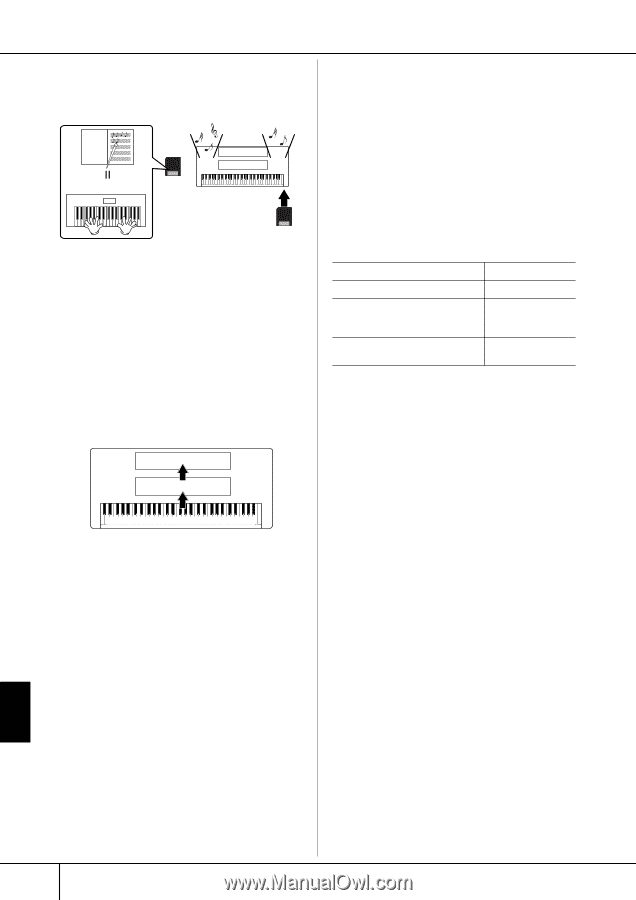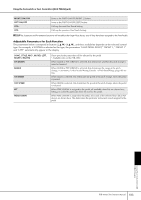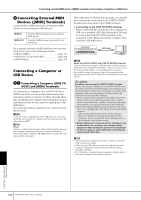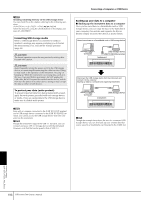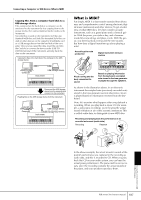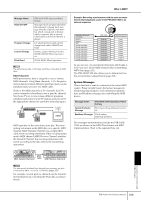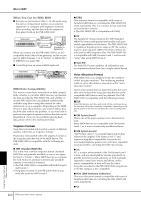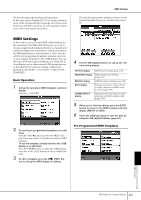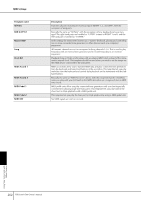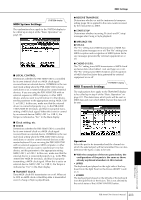Yamaha PSR-3000 Owner's Manual - Page 198
Channel Messages, Example Keyboard Data - equivalent
 |
View all Yamaha PSR-3000 manuals
Add to My Manuals
Save this manual to your list of manuals |
Page 198 highlights
What is MIDI? Recording and play back the performance of a digital instrument (MIDI data) Recording Playback Controller (keyboard, etc.) SmartMedia card Tone Generator Sequencer SmartMedia card n In the case of digital instruments, the audio signals are sent through output jacks (such as [AUX OUT]) on the instrument. The "controller" and "tone generator" in the illustration above are equivalent to the piano in our acoustic example. Here, the player's performance on the keyboard is captured as MIDI song data (see illustration below). In order to record the audio performance on an acoustic piano, special recording equipment is needed. However, since the PSR-3000/1500 features a built-in sequencer that lets you record performance data, this recording equipment is unnecessary. Instead, your digital instrument - the PSR-3000/1500 - allows you to both record and play back the data. Tone generator Sequencer Keyboard performance (MIDI data) However, we also need a sound source to produce the audio, which eventually comes from your speakers. The tone generator of the PSR-3000/1500 fills this function. The recorded performance is reproduced by the sequencer, playing back the song data, using a tone generator capable of accurately producing various instrument sounds - including that of a piano. Looked at in another way, the relation of the sequencer and the tone generator is similar to that of the pianist and the piano - one plays the other. Since digital instruments handle playback data and the actual sounds independently, we can hear our piano performance played by another instrument, such as guitar or violin. n Even though it is a single musical instrument, the PSR-3000/1500 can be thought of as containing several electronic components: a controller, a tone generator, and a sequencer. Finally, we'll take a look at the actual data that gets recorded and that serves as the basis for playing the sounds. For example, let's say you play a "C" quarter note using the grand piano sound on the PSR-3000/ 1500 keyboard. Unlike an acoustic instrument that puts out a resonated note, the electronic instrument puts out information from the keyboard such as "with what voice," "with which key," "about how strong," "when was it pressed" and "when was it released." Then each piece of information is changed into a number value and sent to the tone generator. Using these numbers as a basis for sound generation, the tone generator plays the stored sampled note. Example Keyboard Data Voice number (with what voice) 01 (grand piano) Note number (with which key) 60 (C3) Note on (when was it pressed) and note off (when was it released) Timing expressed numerically (quarter note) Velocity 120 (strong) (strength at which it was played) Panel operations on the PSR-3000/1500, such as playing the keyboard and selecting voices, are processed and stored as MIDI data. The auto accompaniment Styles and Songs also consist of MIDI data. MIDI is an acronym that stands for Musical Instrument Digital Interface, which allows electronic musical instruments to communicate with each other, by sending and receiving compatible Note, Control Change, Program Change and various other types of MIDI data, or messages. The PSR-3000/1500 can control a MIDI device by transmitting note related data and various types of controller data. The PSR-3000/1500 can be controlled by incoming MIDI messages which automatically determine the tone generator mode, select MIDI channels, voices and effects, change parameter values and of course play the voices specified for the various parts. n MIDI data has the following advantages over audio data: • The amount of data is much less. • The data can be effectively and easily edited, even to the point of changing voices and transforming the data. MIDI messages can be divided into two groups: Channel messages and System messages. Channel Messages The PSR-3000/1500 is an electronic instrument that can handle 16 MIDI channels (or reception of 32 channels for MIDI data reception when using the [USB] terminal). This is usually expressed as "it can play 16 instruments at the same time." Channel messages transmit information such as Note ON/OFF, Program Change, for each of the 16 channels. Using Your Instrument with Other Devices 198 PSR-3000/1500 Owner's Manual
